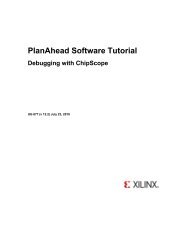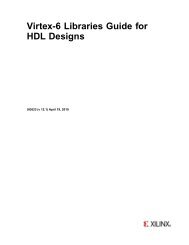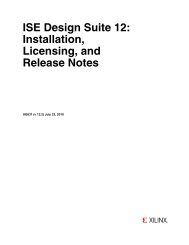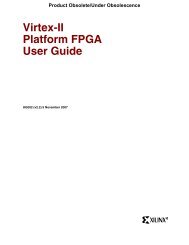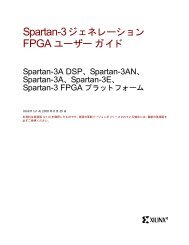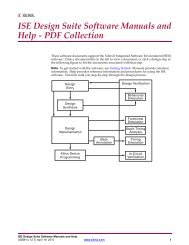XAPP1167
XAPP1167
XAPP1167
- No tags were found...
You also want an ePaper? Increase the reach of your titles
YUMPU automatically turns print PDFs into web optimized ePapers that Google loves.
ColorspacesTable 2: Vivado HLS Synthesizable Video FunctionsVideo Library Functionhls::AXIvideo2Mathls::Mat2AXIvideoDescriptionConverts data from an AXI4 videostream representation to hls::Mat format.Converts data stored as hls::Mat formatto an AXI4 video stream.In particular, the AXIvideo2Mat function receives a sequence of images using the AXI4Streaming Video and produces an hls::Mat representation. Similarly, the Mat2AXIvideo functionreceives an hls::Mat representation of a sequence of images and encodes it correctly using theAXI4 Streaming video protocol.These functions don’t determine the image size based on AXI4 video stream, but use theimage size specified in the hls::Mat constructor arguments. In systems designed to process anarbitrary size input image with AXI4 Streaming interfaces, the image size must be determinedexternally to the video library block. In the Zynq Video TRD, the image size processed by theaccelerator is exposed as AXI4-Lite control registers, however the software and the rest of thesystem is only designed to process 1920x1080 resolutions. In more complicated systems, theXilinx Video Timing Controller core [3] could be used to detect the size of a received videosignal.The video libraries also contain the following non-synthesizable video interface libraryfunctions:Table 3: Vivado HLS Non-Synthesizable Video FunctionsVideo Library Functionshls::cvMat2AXIvideohls::IplImage2AXIvideohls::CvMat2AXIvideohls::AXIvideo2cvMathls::AXIvideo2IplImagehls::AXIvideo2CvMatThese functions are commonly used in conjunction with the synthesizable functions toimplement OpenCV-based testbenches.ColorspacesLimitationsOne important thing to observe is that most OpenCV functions are colorspace independent,meaning that they affect each component of a pixel equally. There are, however, a few notableexceptions, where the byte ordering must be specified, and a few cases, where a default byteorder is used. This default byte order (called BGR or BGRA), places the “B” component in thelow-order bits and the R or A component in the high-order bits of a 32-bit word. The AXI4Streaming Video protocol, however, specifies a particular (somewhat unusual) byte order,which is not directly supported by OpenCV. This format places the “G” component in thelow-order bits, followed by the “B” and “R” components.In the Zynq Video TRD, a portion of the design uses the AXI4 Streaming Video byte order, butframes in memory are stored in the more common BGR byte order. As a result, the examplecode in this application note uses the BGR byte order, which enables consistently usingOpenCV as a design testbench.There are several limitations to the current synthesizable library, which may not be otherwiseobvious. The basic limitation is that OpenCV functions cannot be synthesized directly, andmust be replaced by functions from the synthesizable library. This limitation is primarilybecause OpenCV functions typically include dynamic memory allocation, such as during theconstructor of an arbitrarily sized cv::Mat object, which is not synthesizable.<strong>XAPP1167</strong> (v2.0) August 27, 2013 www.xilinx.com 6




